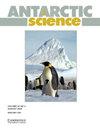Climate and energy balance of the ground in University Valley, Antarctica
IF 2
4区 地球科学
Q3 ENVIRONMENTAL SCIENCES
引用次数: 3
Abstract
Abstract We report 3 years of data from one meteorological and three smaller stations in University Valley, a high-elevation (1677 m) site in the Dry Valleys of Antarctica with extensive dry permafrost. Mean air temperature was -23.4°C. Summer air temperatures were virtually always < 0°C and were consistent with the altitude lapse rate and empirical relationships between summer temperature, distance from the coast and elevation. The measured frost point (-22.5°C) at the 42 cm deep ice table is equal to the surface frost point and above the atmospheric frost point (-29.6°C), providing direct evidence that surface conditions control ground ice depth. Observed peak surface soil temperatures reach 6°C for ice-cemented ground > 15 cm deep but stay < 0°C when it is shallower. We develop an energy balance model tuned to this rocky and dry environment. We find that differences in peak soil surface temperatures are primarily due to the higher thermal diffusivity of ice-cemented ground compared to dry soil. Sensitivity studies show that expected natural variability is insufficient for melt to form and significant excursions from current conditions are required. The site's ice table meets the criteria for a Special Region on Mars, with 30% of the year > -18°C and water activity > 0.6.南极洲大学谷地面的气候和能量平衡
摘要:我们报告了来自大学谷的一个气象站和三个较小的气象站的3年数据。大学谷是南极洲干旱山谷中的一个高海拔(1677米)地区,拥有广泛的干燥永久冻土。平均气温为-23.4°C。夏季气温几乎总是<0°C,与海拔下降率以及夏季气温、距海岸距离和海拔之间的经验关系一致。在42厘米深的冰台上测得的霜点(-22.5°C)等于地表霜点,高于大气霜点(-29.6°C),为地表条件控制地面冰深提供了直接证据。对于深度>15cm的冰胶结地面,观测到的峰值地表土壤温度达到6°C,但当地面较浅时,峰值土壤温度保持在<0°C。我们开发了一个适应这种岩石和干燥环境的能量平衡模型。我们发现,峰值土壤表面温度的差异主要是由于与干燥土壤相比,冰胶结地面的热扩散率更高。敏感性研究表明,预期的自然变异性不足以形成熔体,需要与当前条件发生显著偏离。该地点的冰表符合火星特殊区域的标准,一年中30%的时间>-18°C,水活动>0.6。
本文章由计算机程序翻译,如有差异,请以英文原文为准。
求助全文
约1分钟内获得全文
求助全文
来源期刊

Antarctic Science
地学-地球科学综合
CiteScore
3.60
自引率
6.20%
发文量
42
审稿时长
3 months
期刊介绍:
Antarctic Science provides a truly international forum for the broad spread of studies that increasingly characterise scientific research in the Antarctic. Whilst emphasising interdisciplinary work, the journal publishes papers from environmental management to biodiversity, from volcanoes to icebergs, and from oceanography to the upper atmosphere. No other journal covers such a wide range of Antarctic scientific studies. The journal attracts papers from all countries currently undertaking Antarctic research. It publishes both review and data papers with no limits on length, two-page short notes on technical developments and recent discoveries, and book reviews. These, together with an editorial discussing broader aspects of science, provide a rich and varied mixture of items to interest researchers in all areas of science. There are no page charges, or charges for colour, to authors publishing in the Journal. One issue each year is normally devoted to a specific theme or papers from a major meeting.
 求助内容:
求助内容: 应助结果提醒方式:
应助结果提醒方式:


